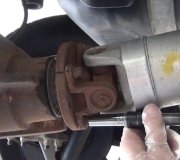1982 Chevy Blazer V8 Four Wheel Drive Automatic
My blazer has has a 6" or so lift with 33" tires.
I've been having some vibration issues with the front end of my blazer. It is a slow speed vibration meaning that its only apparent when I'm driving less than 30 Mph. I thought it might be the front driveshaft. The front driveshaft was wore out so I recently replaced it with a brand new one. I also disconnected the rear driveshaft to see if maybe that was the cause of the vibration. Even with the rear removed and the new front driveshaft there is still a significant vibration. I rechecked the bolts on front shaft and it is still snug.
Also when I drive with the front wheels engaged there is a clicking sound that seems to be coming from the transfer case. The clicking speeds up and slows down as the vehicle does. I checked the fluid level and it is ok.
Please help I really don't want to rebuild a front axle or transfer case if it can be prevented. Thank you.
SPONSORED LINKS
Monday, November 10th, 2008 AT 11:49 AM



